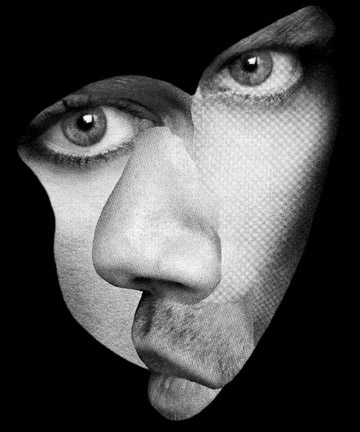Do You See Yourself in the Media?: “In the Mirror”
Valerie Valentine saw "In the Mirror" by Pangea World Theater at the Playwrights' Center (2301 E. Franklin Ave., through April 24). It's an arresting plethora of media commenting on media.

Twin Cities writers and performers managed to extricate themselves from the cyclone of consumable media to interpret how messages and their medium are affecting our lives. Pangea World Theater’s collaborative performance of In the Mirror mocks, pokes fun, and rages at the idiosyncrasies and failures of mass media to represent society as a whole.
Through the accomplished direction of Dipankar Mukherjee, and with the brisk sketch formula of Meena Natarajan’s script, the eight-person ensemble asserts a startling breadth of commentary in less than two hours. Much of the variety may be attributed to the vast amount of media employed in the performance’s execution. In the same way citizens are inundated with an onslaught of media messages every day, so are the audience members for In the Mirror.
Minimal props–a few staggered chairs and stools–keep the space open for a clear view of the projected imagery. Prerecorded and live video is projected onto tall, gauzy screens set as backdrops, like a movie theater or big-screen TV. The vast array of sounds by Chad Dudycha includes electronic and jazz music blasts in intriguing snippets, much like the brief musical segues on MPR. Michael Wangen’s lighting work adds to the goosebump factor in climactic moments throughout the show, going from stark office-white light to moody blue and red, down the spectrum to pitch black.
Monologues, faux newscasts, poetry, disembodied voices on cell phones, shuffled memos, keyboard clatterings, modem buzzings, and choreographed striding, posing, and dancing around the stage makes for a jumbled bag of discourse. The artists prove their point in as many ways as possible. There are as many individual points as modes of presenting them. Uniform silky costumes by Linae Enockson help to link the varied players.
It was a team effort from the start. The creative process developed diverse artists’ answers to questions regarding media, from “Do we get the media we deserve?” to “Is arts considered the media?” to “How do you keep from being trapped in your own rhetoric?” The troupe acknowledged that the questions were subjective, and so instead of giving solutions to any dilemmas that arose from the discussion, the play presents a smash-up of opinions and experiences. The performance succeeds in making one consider the media’s effects on one’s own life. The rapid-fire barrage verges on overstimulation, as does our current ADD-inducing media environment.
The artists reveal their levels of involvement with media. There are movie buffs and news junkies, bloggers and novelists, poets and TV-boycotters. Through their presentations, modern media is revealed as vice: people are addicted to Lifetime movies, Netflix, the Travel Channel, cellphones, iPods, magazine subscriptions, internet porn, and more.
In the Mirror’s creators have clearly researched this behemoth, and have looked at the scariest statistics from many sides. The performers even make convincing arguments for the government to arrange television programming, in a sketch where the CIA presents a war-on-terror reality TV show to some network executives. Of course it’s satire, but their rhetoric is alarmingly persuasive. Indeed, in a later sketch, a simpering news host illustrates how easily (and infuriatingly) corporate media twists the words of others; in this case, a badly translated Iraqi citizen who lost family members in US attacks is made to seem grateful for US intervention, even while he angrily gestures, wails, and weeps.
Sweet details keep the show rolling, and tie the disparate skits together. For example, the programs are printed on newsprint. When I walked into the theater, for a surreal moment it looked like everyone was reading the same newspaper. An unused pile of TVs and old technology at the stage corner becomes a silent witness, reversing the usual relationship of viewer/viewed. Useless repetitive chatter in one sketch–“How you doing? Good! How you doing? Good!” –mimics the empty messages we are exposed to constantly, while perhaps commenting on our poor interpersonal communication skills despite our media-saturated world. A heartbeat sound and EKG line at intervals across the performers remind us that even though the media might seem to represent the “pulse” of our culture (if it does, we’ve definitely got hypertension!), the truth of a person’s experience of reality is at the heart of each individual.
A skit about surveillance engages abstract dialogue and actions, while remaining convincingly creepy, thanks to the great sound and visual effects. A man with a foreign accent is watched, photographed, and videotaped by not-quite-innocuous coworkers. Someone is listening to his phone conversations and monitoring his reading materials, and even his internet usage. The troupe’s treatment of surveillance suggests, that Big Brother is watching you, and also alludes to xenophobia perpetuated by United States media through cultural ignorance (news anchors’ mispronunciation names of people and places) and paranoia (Arab = terrorist).
J. Otis Powell! asks, “When is the last time you saw yourself in the media?” This simple question can open many doors in the mind. Whether or not the media is your mirror, you must look to yourself to create a personal reflection for the rest of the world to see. Although none of us can claim to be unaffected by the news, billboards, commercials, magazine covers, television programming, web pop-ups, radios, and more that crowd our existence, we can choose what we consume and how often we consume it. And, as these artists have done, we can be the media.
To attend In the Mirror at the Pangea World Theater
(Thursdays-Saturdays, 8pm, Sundays 2pm, through April 24) call The Playwrights Center, 612-822-0015, or click the link below.